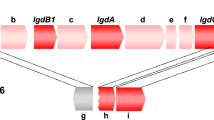Abstract
Two varieties of enzyme repression have been observed in micro-organisms. In one, addition of the end-product of a biosynthetic pathway to the growth medium specifically prevents synthesis of enzymes concerned with the formation of the product in question. In the other, synthesis of a degradative enzyme is repressed by an end-product (or a closely related metabolite) of the action of the enzyme. Several authors1,2 have suggested that a repressing metabolite may exert its effect by combining with newly formed (‘nascent’) enzyme and, thereby, somehow preventing its release from the site of synthesis. Extending this notion, it could be supposed that enzyme formed under non-repressed conditions might still retain ‘recognition’ sites accessible to a repressing metabolite. Binding of the metabolite to these sites might then be expected to alter certain properties of the enzyme, such as heat stability. It is commonly observed that the heat stability of an enzyme is altered when it is in combination with a substrate or an inhibitor. As an approach to testing for the possible existence of “repression recognition sites”, we have examined the effects of metabolites derived from glucose on the heat stability of Escherichia coli β-galactosidase. The synthesis of this degradative enzyme, as well as several others, in E. coli is repressed when glucose is present during growth and can be similarly affected, though to a lesser extent, by any compound that can be used as a carbon source by the cells3. The active repressor is not glucose itself but some compound, as yet unidentified, that is derived from it.
This is a preview of subscription content, access via your institution
Access options
Subscribe to this journal
Receive 51 print issues and online access
$199.00 per year
only $3.90 per issue
Buy this article
- Purchase on Springer Link
- Instant access to full article PDF
Prices may be subject to local taxes which are calculated during checkout
Similar content being viewed by others
References
Vogel, H. J., Proc. U.S. Nat. Acad. Sci., 43, 491 (1957).
Szilard, L., Proc. U.S. Nat. Acad. Sci., 46, 271 (1960).
Mandelstam, J., Biochem. J., 79, 489 (1961).
Mandelstam, J., Biochem. J., 82, 489 (1962).
Craven, G. R., Steers, E., and Anflnsen, C. B., J. Biol. Chem., 240, 2468 (1965).
Janǎcek, J., and Rickenberg, H. V., Biochim. Biophys. Acta, 81, 108 (1964).
Atkinson, D. E., Science, 150, 851 (1965).
Author information
Authors and Affiliations
Rights and permissions
About this article
Cite this article
GEST, H., MANDELSTAM, J. Heat Denaturation of β-Galactosidase: a Possible Approach to the Problem of Catabolite Repression and its Site of Action. Nature 211, 72–73 (1966). https://doi.org/10.1038/211072a0
Issue Date:
DOI: https://doi.org/10.1038/211072a0
This article is cited by
-
Fructose-1,6-bisphosphate, a regulator of metabolism
Molecular and Cellular Biochemistry (1977)
-
Biological sciences: Allosteric Preconditioning: Role of Allosteric Ligands in Promoting the Maturation of Enzymes
Nature (1971)
-
Metabolite-promoted Heat Lability of β-Galactosidase and its Relation to Catabolite Repression
Nature (1967)
Comments
By submitting a comment you agree to abide by our Terms and Community Guidelines. If you find something abusive or that does not comply with our terms or guidelines please flag it as inappropriate.



